Formula E reaches its 10th anniversary with a typical cliffhanger season
Critics were cruel, saying Formula E wouldn’t last and that its cars might even cook the competitors. Ten years on, the series is in fine health but as Sam Smith explains, F1 is about to rudely barge into its territory

Getty Images
A decade ago this month, Formula E was gearing up for its first race in Beijing. Following testing in the summer of 2014 there were serious concerns after mocked-up races had turned to farce at Donington ahead of the big day. Would the cars leave the grid? Could they all finish the race? And even, would they fry their drivers?
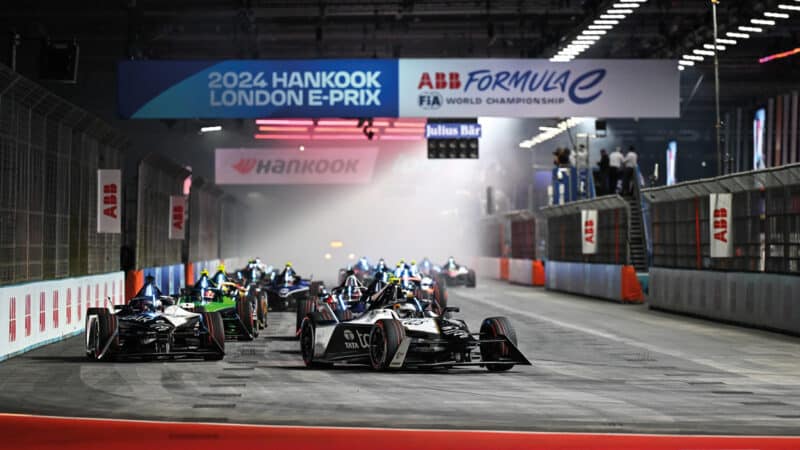
July 21, 2024 – the 10th season reached its thrilling climax in London’s ExCeL
LAT
At best there was scepticism. At worst a kind of hysterical derision of cars that made little noise and were slower than F3 cars. But they did get off the grid, they finished the race (mostly… Nick Heidfeld was pushing for the lead when he crashed on the final corner) and no drivers were fried in the process. It wasn’t exactly a glittering triumph but it proved that all-electric racing cars could make a show.
“In 2014 there were serious concerns after mock races turned to farce”
Those pioneering days of two cars per driver and random inclusions like Michela Cerruti and Salvador Durán on the grid are over. A decade on and Formula E is a slick world championship with the cream of talent and prestige OEMs like Nissan, Porsche and Jaguar as long-term factory operations.
There is a cost-cap, shiny races at Monaco, Tokyo, London and Mexico City, as well as a strong Saudi Arabian commercial strand that encompasses Neom (a new urban area in the north-west of the country), airline Saudia and Electric 360, a partnership to promote electric motor sport which involves Extreme E and is owned by the Public Investment Fund of Saudi Arabia (an entity that is one of the largest sovereign wealth funds in the world).
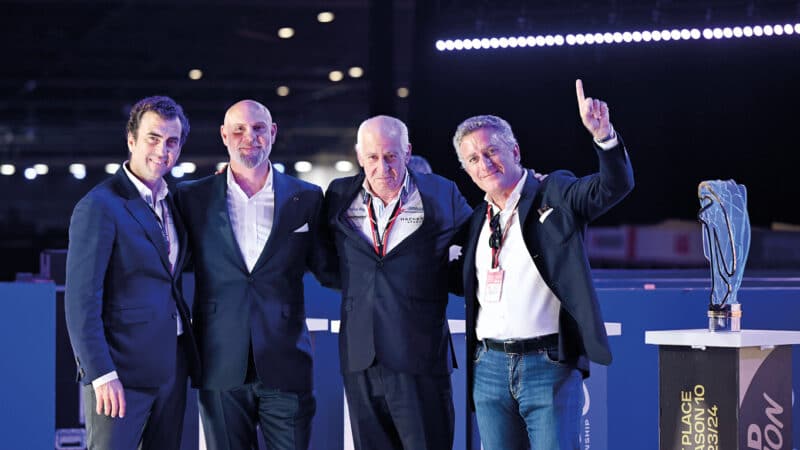
From left, Formula E execs Alberto Longo, Jeff Dodds, Manolo Ortiz-Tallo and Alejandro Agag
Getty Images
Its 10th season culminated in July with another dramatic run-in as Pascal Wehrlein, Mitch Evans and Nick Cassidy fought out a thrilling last-gasp duel in London. Wehrlein won in dramatic circumstances, while Jaguar TCS Racing scooped its first title.
Eight winners from 16 races and grids of 22 cars being separated by no more than 0.3sec on average shows that the FIA and Formula E got the basics of the Gen3 rules set right. It was painful getting there with several technical challenges to be overcome… but get there it did.
Against that backdrop is the fact that in June 2024 it was confirmed Liberty Global would be acquiring a majority holding of the all-electric world championship, taking shares that the Warner Bros Discovery group invested in (when it was known as Discovery) in March 2015. That effectively saved Formula E from the abyss, after the initial investment money had run dry forcing founder Alejandro Agag to help freight the cars from Buenos Aires to Miami in early 2015 with his own credit cards. The plan now is clearly to invest in extolling Formula E’s strengths to try and gain traction in the media, especially through streaming services.
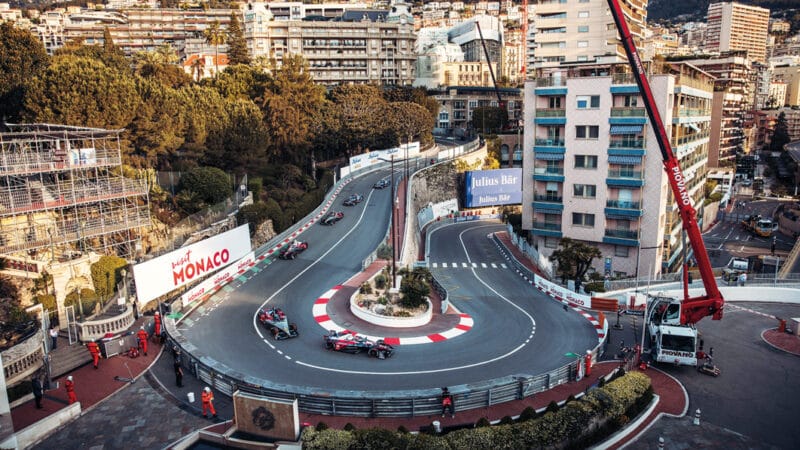
Monaco is a double-header in 2025
LAT
Formula E’s CEO Jeff Dodds has been forthright in making more noise about the electric series and generally he hasn’t disappointed. Yet, he is also pragmatic about Formula E’s positioning and its young age compared to other motor sport disciplines like F1 and WEC.
“I use the analogy of snakes and ladders a lot,” Dodds says. “There are definitely ladders every day. There’s great stuff that happens but there’s also snakes every day too because we’re in a growing business and we’re trying to do so much.

In the final weekend of ’24 it was possible for seven drivers to take the title
Getty Images
“On balance, we’re trying to make sure the ladders are always bigger than the snakes. I think this season they have been. We had the Hyderabad and Indonesia [Jakarta] race location changes, which are things that are disappointing and frustrating. But then we had a couple of massive ladders and the PIF [Public Investment Fund] coming in makes people take notice.
“We’re in a growing business and we’re trying to do so much”
“Liberty arriving and buying out the Warner Bros Discovery share and so taking majority ownership gives some conviction in our growth plan and Liberty having the capital to allow us to realise that growth and ambition was a really important moment.”
That growth plan includes getting bigger broadcasters and more streaming services in place as soon as possible, with Dodds having been known to have already engaged with some of the big California-based streaming platforms prior to the season end.
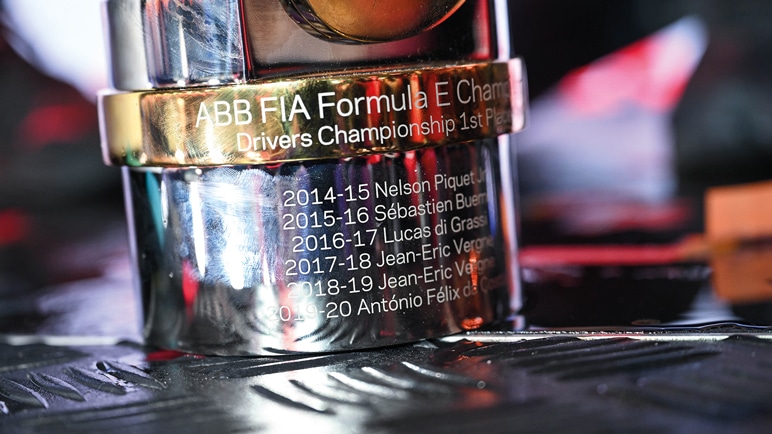
Jean-Éric Vergne is the only person to have won the title twice
Getty Images
“I think we’re at a stage in our business where we need to have great relationships with large national broadcasters, whether they’re free-to-air broadcasters or pay providers, but we need to have in each of our core markets great relationships with big, big free-to-air or digital providers,” adds Dodds. “We’ve done a very good job of that with a few exceptions. During the off-season we have a couple of markets where we have to find better access for our fanbase.”
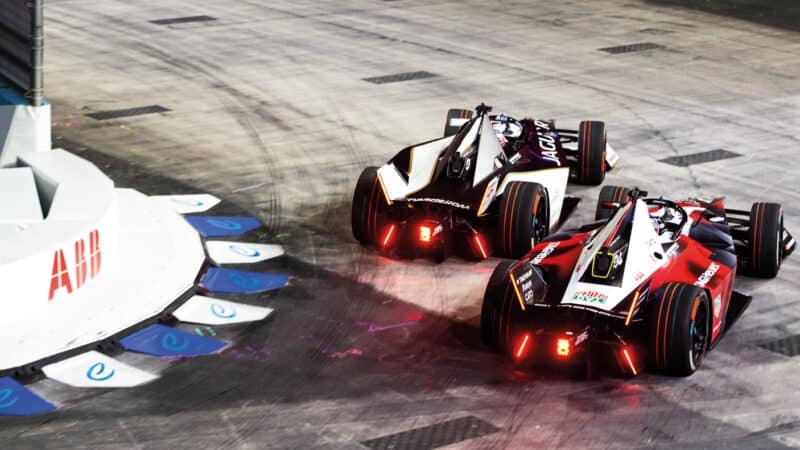
There’s no doubt that Formula E is a trailblazing championship, which is why this magazine presented the series with a special award at our centenary celebration
Getty Images
That includes the UK which has been covered by the TNT network this season. The figures have been poor and the reaction of existing fans of going completely behind a paywall, with the exception of the London finale which was also covered on free-to-air Quest channel, has been mostly negative.
Along with that priority is getting a sizeable streaming deal, and Dodds is unequivocal in his desire to ensure Formula E does not just copy the Drive to Survive model that has proved so successful for F1.

Those title contenders in London, from left: Oliver Rowland, Nissan; Jake Dennis, Andretti; Jean-Éric Vergne, DS Penske; Nick Cassidy and Mitch Evans, Jaguar TCS; Pascal Wehrlein and António Félix da Costa, Porsche
Getty Images
“We can’t just try and do exactly what other people have done before us because I don’t think that’s a challenge,” said Dodds. “I think the challenge is: how do we find the streaming proposition that brings a new audience to Formula E but isn’t a replication of what’s gone before?”
While the media landscape is one priority, another is a more existential question that has been bouncing around for some time which centres upon the future of all-electric motor sport in general – how more EV technical use in Formula 1 could affect the perception of their being an absolute need for Formula E.
Formula 1 will have 47% electric power within its mix for the new 2026 regulations, ensuring it has a decent EV message. Could that dilute Formula E, especially should it continue to suffer from a lack of visibility via free-to-view TV?
As of June 2024, there are 1,145,000 fully electric cars on UK roads, compared to the Society of Motor Manufacturers & Traders’ data of just 37,842 from 2014. That’s a large uptake and one that manufacturers involved in Formula E have taken a great deal of their future strategy from.
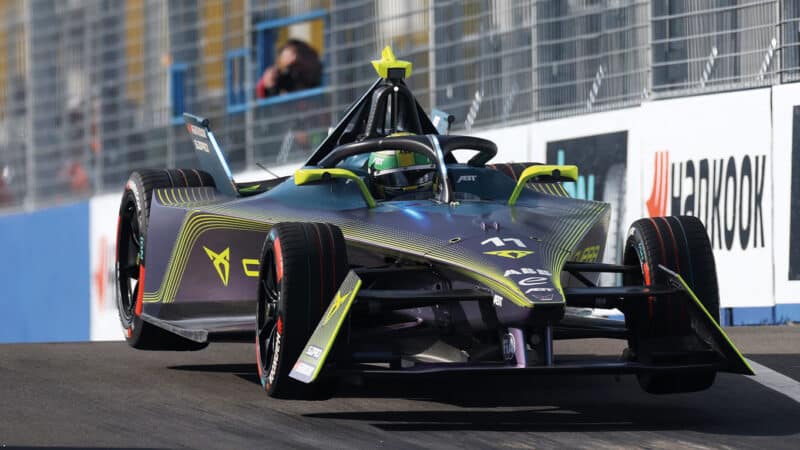
ABT Cupra’s Lucas di Grassi gets air in the 2024 Tokyo ePrix
Getty Images
But if Formula 1 starts to lead the EV message it could become problematic in the long-term for Formula E. Dodds doesn’t particularly see that though, saying that “the existential moment is always coming because Formula 1 is racing on internal combustion technology, whether it’s 2035 or whether it moves out slightly depending on which government you’re talking to and what their regulations are.
“Racing with the internal combustion engine will be irrelevant”
“There is a moment coming when it’s going to be about alternative fuels because, in my opinion, continuing to race predominantly using the internal combustion engine is no longer going to be relevant to anybody. Let’s remind ourselves that we [Formula E] have exclusive rights under the FIA to race only electric, so that sits with us.”

Nicki Shields and Catie Munnings on TNT trackside duties
Getty Images
That exclusivity clause is believed to be until 2039, by which time hydrogen-powered motor sport will most likely have found its feet and range. Whether this impacts on what a second epoch of Formula E might look like remains to be seen.
For now, Formula E can quite rightly allow itself a little time to stand back and be proud of its achievements – not just over the last season, but the last decade. It has proved many doubters wrong simply by still being in existence. But its unbridled ambition, the continuing support of the FIA and the manufacturers, as well as a buoyant driver market which sits outside of the financial regulations, means it is in decent shape.

This season there have been eight different ePrix winners
Getty Images
Its calendar at last appears to be reasonably stable with no changes expected between the provisional dates being announced in June to it actually beginning in December. That has been a rarity in previous seasons, and with an expansion of Tokyo and Monaco to double-headers next season there are two nailed-on big-corporate, big-commercial events that can showcase Formula E in a glowing and progressive light.
The mix of tracks has become a major focus in recent seasons with the glamour locations of Hong Kong, Rome and Paris having been disregarded. Shanghai and Misano entered the fray in 2024. Shanghai kind of worked; Misano didn’t.
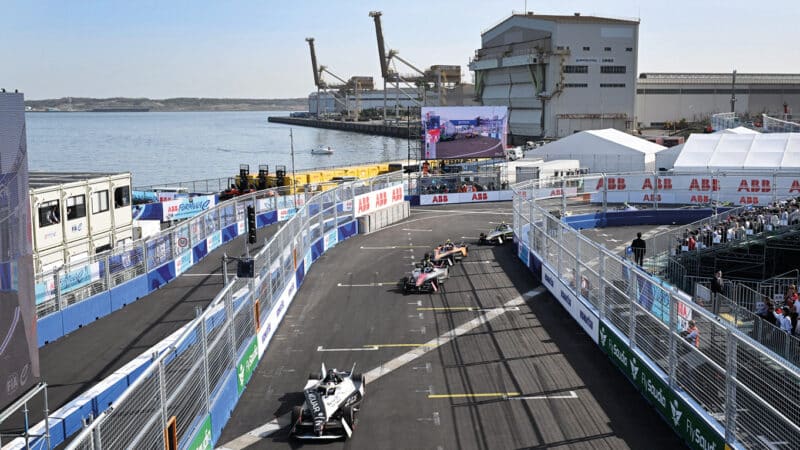
Formula E came to Japan for the first time in 2024 highlighting its global ambitions. The race took place on a new street circuit around Tokyo Bay
Getty Images
But like Formula E’s own burning ambition, the cars will outgrow some of the tracks, meaning that a branching out to more-ambitious, self-created facilities with permanent circuits will be the defining element for the future.
That future doesn’t feel as though it’s hanging tenuously as it did in the immediate post-Covid years of 2022 and ’23. Yet, as ever with international motor sport outside Formula 1, Formula E still has to fight tooth and nail to be seen and heard.